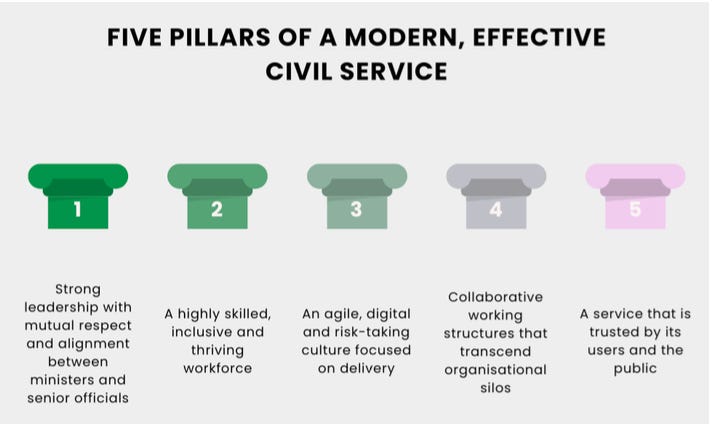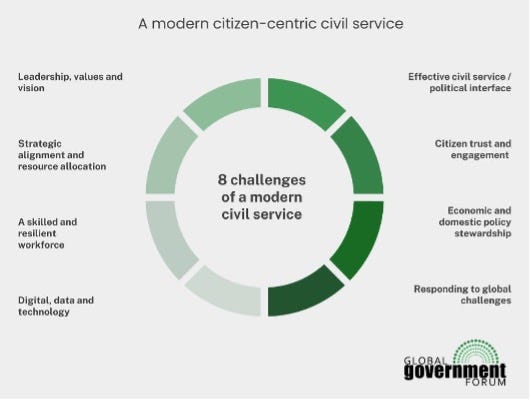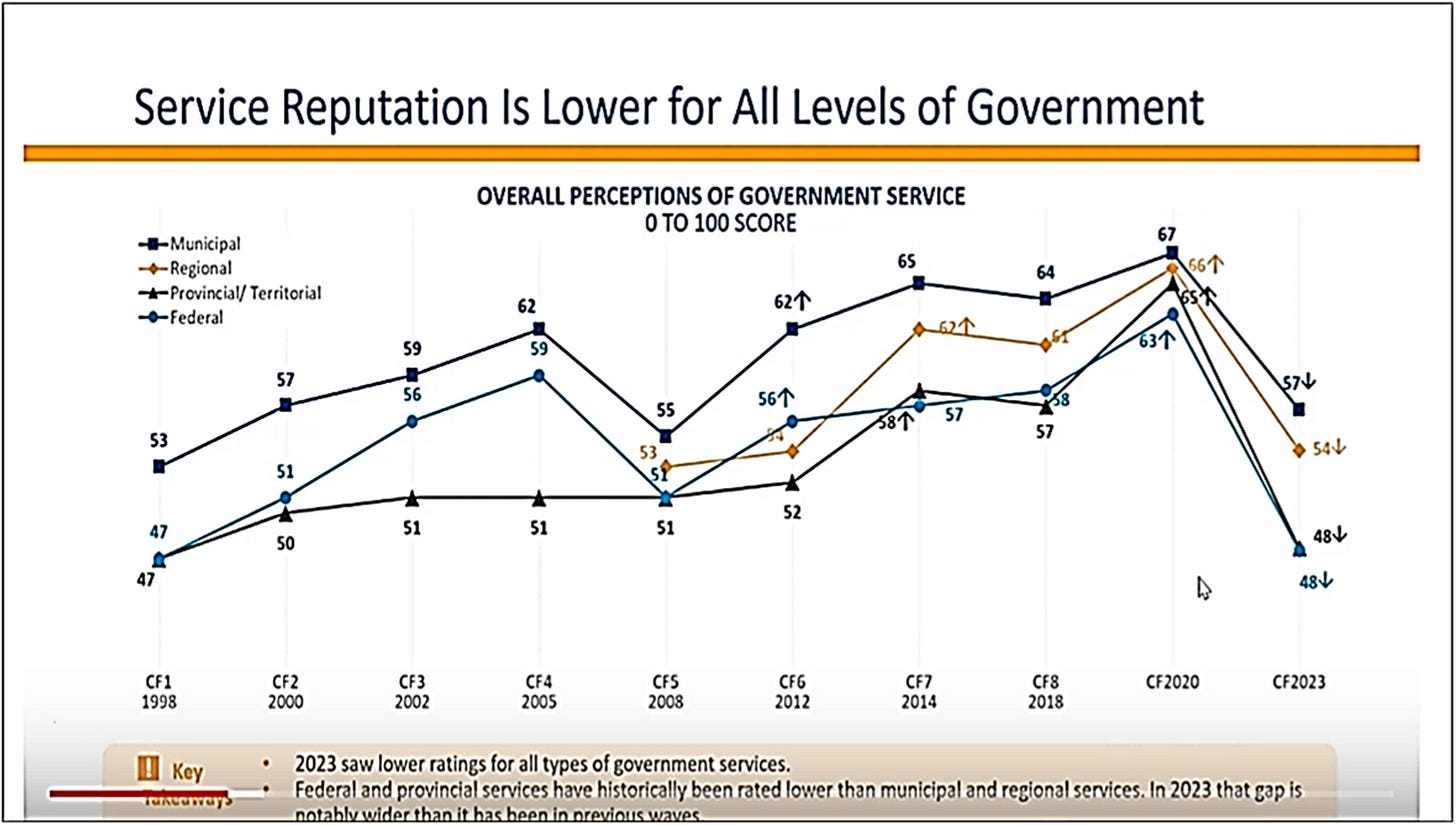The new Mark Carney governing agenda will require a strong, dynamic public service to implement. A report last year by the Global Government Forum offers a framework for “a modern, effective civil service”. It’s worth a reprise, which I do here, given what’s ahead for our new government.
Uniquely, this report is informed by interviews with a dozen public service heads around the world, including Canada and the United Kingdom. Its recommendations seek to identify the common foundational elements for strong, dynamic civil services whether they are – in the words of the report – “already pioneering models of excellence or are in the earlier stages of government and service reform.” They are high-level but valuable in the broad canvas they paint. More to the point, in the absence of a Canada-only report, they offer a useful starting point to consider what the federal public service needs to do.
Five Pillars
The figure below sets out five pillars of a modern, effective civil service:
Within each pillar are a series of specific steps to reinforce them.
Pillar 1: Strong leadership with mutual respect and alignment between ministers and senior officials
A strong, trusting relationship between political masters and public servants is at the core of this pillar. There is a desire to have a closer affinity between short-term immediacy in political priorities and so-called poly-crises, and the longer-term goals of any government. Civil servants consider themselves stewards of well-functioning, non-partisan governance institutions and processes – ‘the system’. Populism and attacks on public servants and institutions – ‘the system’ – is challenging the ability of securing that respect and alignment.
Four areas are proposed to address this:
Establish a clear understanding of political objectives and civil service stewardship – to maintain accountability, translate directions into action and results, and ensure impartiality in advice and conduct.
Implement better training for ministers and civil servants – as to roles and responsibilities for each, to bridge knowledge gaps in how institutions function including legal and financial frameworks.
Safeguard and reinforce the provision of impartial advice – to ensure officials can speak ‘truth to power’.
Cultivate leaders who actively defend civil servants in public forums – having both political and civil service leaders able and willing to address shortcomings and attacks on integrity and impartiality.
Pillar 2: A highly skilled, inclusive and thriving workforce
Contemporary public policy and public service management problems require modern, trained, and properly skilled public servants to deal with them. Traditional policy development and civil service administration skills are insufficient to meet today’s disruptive policy environment and technology advancements, such as AI.
Four areas are proposed to address this:
Revamp recruitment practices to be more effective – this means ensuring salaries are competitive, proactive talent spotting, and encouraging interchange between the public and private sectors.
Reduce reliance on consultants by building internal capabilities – rebuild stronger internal capacity, save money, ensure proper skill sets within government.
Prioritize staff wellbeing and mental health support – through flex working arrangements, managing workloads.
Develop the next generation of leaders – understanding motivations of young recruits towards work, public service, and advocacy.
Pillar 3: An agile, digital and risk-taking culture focused on delivery
Ministers and the public at large both want government to act more quickly and effectively. Established institutional structures and processes, as well as traditional cultures of doing business, get in the way of this. Confronting internal risk-aversion cultures, being innovative in approaches, and using new technologies such as AI (cited as a “game changer”) are all seen as ways to do this. The pandemic underscored both the need and the ability of public services to respond quickly and effectively to meet the overwhelming public health crisis.
Four areas are proposed to address this:
Champion innovation and supporting risk taking – dismantle risk-aversion cultural barriers, innovate internally through labs, identify innovation champions.
Secure the digital, data and technology infrastructure necessary for transformation – invest in replacing antiquated, clunky IT systems.
Lead the way with public sector AI utilization – put in place AI tools and frameworks for its use across government, designated AI leads or champions within departments, develop courses to teach AI to civil servants.
Design services with the customer in mind – improve customer experiences with government services through greater digitization, focus on specific services and improve them one-by-one, integrate customer and policy design at the outset
Pillar 4: Collaborative working structures that transcend organizational silos
A modern civil service “needs to operate horizontally”. This pillar gets at the bureaucratic barriers preventing ‘joined-up’ government and the institutional pressures of acting in a siloed capacity. There is a demonstrated need for more integration of government departments and agencies for everything from policy making to data sharing. The pandemic required this to occur, and modern, effective civil services should make this the norm. Big issues such as climate change and getting to net-zero reinforce this requirement.
Four areas are proposed to deal with this:
Empower a strong central authority to oversee and enforce collaborative efforts – move away from a ‘lead department’ model to a strong central authority to manage and direct,
Integrate political and official decision-making to streamline processes – utilize cabinet committees or joint political/official decision-making groups
Properly resource initiatives that facilitate cross-government working – to ensure full-time attention by designated officials on horizontality in government,
Maintain a long-term focus to overcome the transient challenges of political cycles – make internal structural reforms and establish long-term goals to drive government funding and decision-making, invest in effective long-term policy making and capacity.
The figure below illustrates different models to accomplish this:
Pillar 5: A service that is trusted by its users and the public
Trust in government is being eroded by populism, disinformation, deepfake technologies, and social media. Governments need to reestablish and maintain trust in response. Effective public service delivery to citizens is central to the trust bond between governments and the governed.
Four areas are proposed to deal with this:
Build trust by showcasing success stories – highlight where and how government has helped and served people well.
Establish comprehensive strategies to tackle the spread of fake news – establish communications units and develop strategies to actively confront fake news.
Maintain open and effective communication with all citizens to foster inclusion and transparency – particularly with digital services by ensuring data privacy and protection.
Strengthen international alliances to bolster credibility and share best practices in civil service – ensure allied civil services are operating credibly and effectively with each other and sharing best practices.
Challenges Facing Civil Services
The Global Government Forum developed the following figure to identify the principal challenges facing modern civil services today in creating a truly citizen-centric form of governance.
To Govern is to Choose
There is a lot of advice in this report. Not all of it is pertinent to Canada’s circumstances. Nor can any public service undertake all of these items at the same time with the same vigour. Some are longer term in horizon; others need to begin now knowing they will only truly gestate later. Governing means making choices.
Let’s align the above pillars and recommendations with Prime Minister Carney’s agenda so far. Based on the Liberal platform and statements to date, he wants to:
Build things faster
Deliver services more efficiently and effectively to citizens
Create a more productive public service using AI and digital tools
Reallocate current spending priorities to his new, priority areas
Transform the public service and cap its size,
The finance minister has announced an expenditure review for the budget sometime in the Fall (Fall officially ends December 20th, btw). Money has traditionally been the driver of public service reform. M. Champagne’s first budget will certainly maintain that tradition. The question becomes: will there be a more formal, deliberate PS transformation exercise undertaken by this government to ensure it achieves want it wants to achieve?
Each of the 5 pillars is relevant to Canada’s federal public service (provincial ones too!). But our new(ish) PM strikes voters as a ‘man on a mission’; someone who wants to do things sooner rather than later. At least for now. On that basis, he should choose to focus on the following pillars first:
Pillar 1: Strong leadership with mutual respect and alignment between ministers and senior officials. IMMEDIATE.
Public service reform only occurs when there is alignment between the politicians and the officials. The PM and his Clerk of the Privy Council need to be ‘joined at the brain’ on the need to do this and willing to collaborate - and be seen to collaborate - to get it done. This is especially crucial in the short window of a minority government.
Two things that matter most in the early days: giving Cabinet ministers greater individual authority and autonomy to run their departments and agencies; giving senior officials greater authority to ‘speak truth to power’. In a word: accountability. It has gone AWOL too much for too long at the federal level. These two steps would begin the hard but necessary path forward to restoring it. It is essential for the culture shift that needs to occur in official Ottawa.
Pillar 4: Collaborative working structures that transcend organizational silos. SHORT-TERM
When I was running the Institute on Governance, we conducted an independent, third-party survey of current and former deputy ministers, asking them to identify the most important governance issues facing them. Collaborative governance was number one. Importantly, this was both horizontal across the federal government itself as well as vertical with other levels of government. Figuring out how to effectively work together to accomplish things is both a challenge in our federation but a needed skill that is not always there.
Creating the right governance mechanisms and processes to do this is an ongoing challenge. While this was done during the pandemic (something I had direct experience with as Clerk of the Executive Council and Cabinet Secretary in Manitoba), this is not alway the institutional practice ‘in peacetime’. PM Carney and PCO Clerk Sabia will have to determine the correct balance between running everything from the centre or returning to a more traditional model of Cabinet management.
But the time is ripe for an alternative approach. In truth, central coordination matters only on a few files: the ones the PM chooses. Choose those wisely and put in place the governance to make those happen. This will take a bit of time (not long) but can gel very fast with the right leaders, authority, and accountability. Commence now and adjust it over the next year to 18 months.
Pillar 3: An agile, digital and risk-taking culture focused on delivery. MEDIUM-TERM
“Culture eats strategy for breakfast” said the famous management guru, Peter Drucker. It means that internal organizational culture matters more to the success of the organization (private, public, or non-profit) than any strategic plan. Public service culture is famously (and sometimes mistakenly) considered slow, cumbersome, detached, and risk-averse. Changing an organization’s culture takes time … and leadership (hence, ‘medium term’). In the case of government, that means leadership from ministers and their deputies. To get the picture, read these two quotes from public servants cited in the Clerk's Values and Ethics Report:
“There is selective enforcement of values and ethics within the public service. The higher up the food chain you go, the less accountability seems to exist.”
“The perceived ethical behaviour at the senior leadership level sets the tone for the organization. … the daily culture is really due to the senior leadership…”
What about service delivery? It’s taken a hit. Here’s a chart showing a decline in service reputation for ALL levels of government (post-pandemic). But the feds are worst. So, improvement is called for.
(Source: https://onlinelibrary.wiley.com/doi/full/10.1111/capa.12595)
The Liberal platform makes a big play for AI and digital service tools to improve public service productivity and, by extension, service delivery. It may well do just that. But investments in these tools and delivery mechanisms has not kept pace with the need or opportunity. The pandemic taught us all a lot about how this can work. But it also reminded us that many of the federal IT systems need to be modernized…fast.
A key factor in federal shortcomings on service delivery (which are not uniform, btw, there are successes) is the lack of visibility and accountability given to operational matters by senior officials and politicians. I stand by my own public recommendation for creating a Chief Operating Officer for the federal government and COOs in each department and agency, as I wrote here and here in the Globe and Mail. That would start to change the culture of government towards service delivery excellence.
There is obvious crossover with the other pillars. They are all interdependent. Advancing each has value. What doesn’t have value is thinking all or equally important right now and that all must be done or none at all. Better service delivery will build trust with Canadians (Pillar 5). Adopting AI will require trained public servants (Pillar 2). And so forth.
Mr. Carney has an agenda. The public service needs to improve itself to implement that agenda. Time to choose. Time to act.








Thanks for sharing the comparative lessons learned/recommendations and your take on what Carney should focus on. Part of the cultural challenge facing the public service is the hierarchy between the policy folks at the top and the operational and service delivery folks largely at the bottom. No easy fix (I worked at Service Canada when we were trying, unsuccessfully, to shift the balance.
I’m all for improving the civil service but this report is just a bunch of buzzwords and corporate garble.